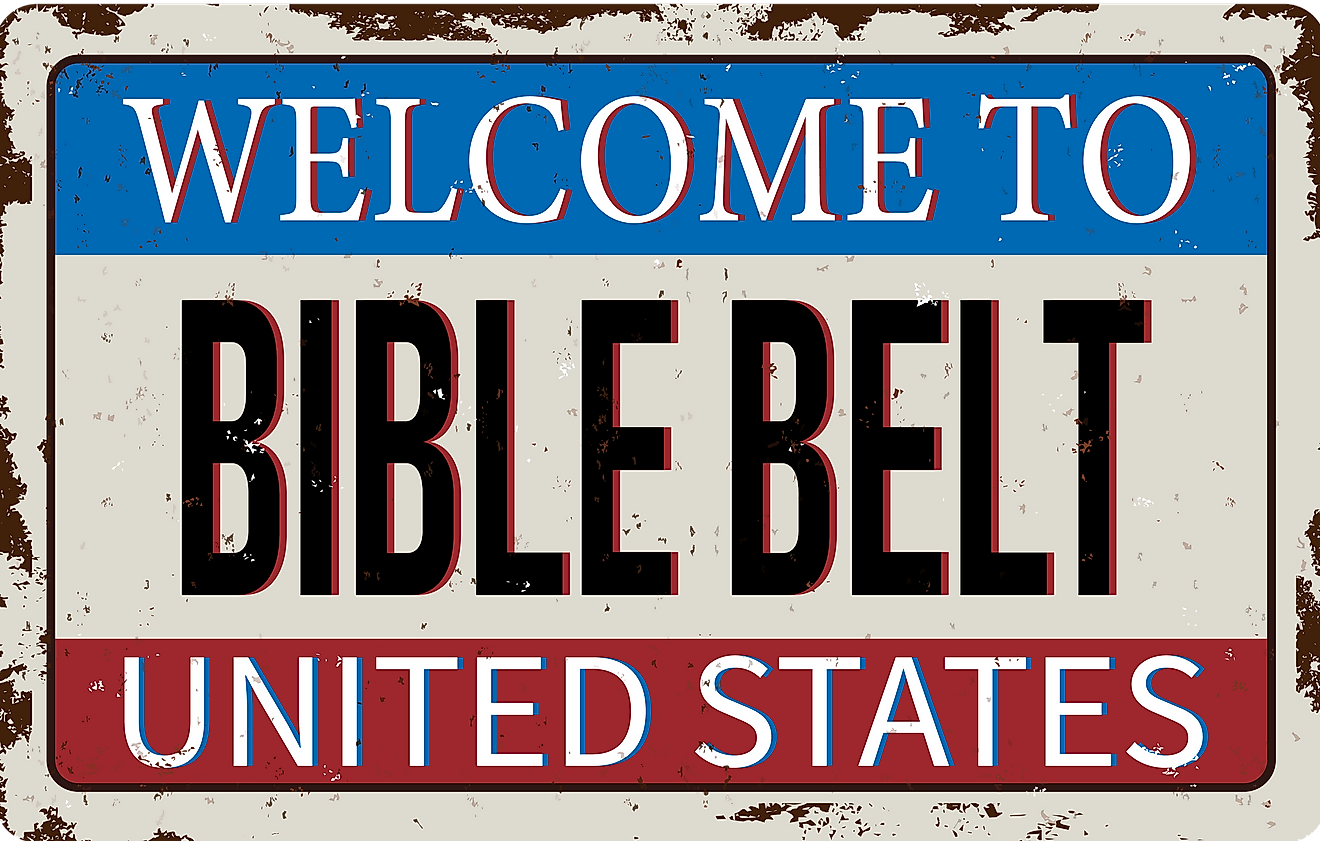Bible Belt States

- The Bible Belt generally refers to a vast region encompassing most of the U.S. South and parts of some northern states.
- The term “Bible Belt” was coined by a journalist covering the Scopes Monkey Trial in Tennessee in 1924.
- Protestant denominations like the Southern Baptists, Methodists, and evangelical churches are the dominant faith groups in the Bible Belt.
- The people of the Bible Belt tend to elect conservative politicians at the state and federal level, and have socially conservative values.
Generally speaking, the term “Bible Belt” is used to describe a wide swathe of territory comprising most of the U.S. South, though the term may also apply to the southern parts of some northern U.S. states, including Illinois, Indiana, and Ohio. In addition, the southern parts of Florida and Texas are not generally considered to be part of the Bible Belt. The region is one in which people are strongly devoted to their Christian faith. Indeed, their faith affects many aspects of their lives, including their politics and social values. In other, more liberal parts of the U.S., people in the Bible Belt are sometimes mocked for their religiosity. In fact, the very term “Bible Belt” was first used to criticize the religious fervor of people living in the region.
Origin Of The Term “Bible Belt”
The term “Bible Belt” is thought to have been coined by a journalist named H.L. Mencken, who first used the term in 1924, when he was covering the Scopes Monkey Trial in Dayton, Tennessee. The term first appeared in one of his articles that he wrote for the Chicago Daily Tribune. Mencken used the term in a derogatory way, mocking the religious zealousness of the people in the vast U.S. region. In fact, when describing the region, he also referred to it as the Hookworm Belt and Lynching Belt.
Defining The Bible Belt

In 1961, a geographer named Wilbur Zelinsky argued that the Bible Belt consisted of areas in which the Southern Baptists, Methodists, and evangelical Christians were the predominant religious denominations. These areas comprised most of what constitutes the U.S. South. Interestingly, however, he did not consider the southern parts of Louisiana, Texas, or Florida as being part of the Bible Belt, no matter how religious they were. His reason for excluding these parts of the U.S. was that they were not overwhelmingly Protestant. Southern Louisiana was mostly Catholic, Southern Texas was mostly Hispanic, and Southern Florida was demographically very diverse. Hence, Zelinsky implied that the term “Bible Belt” should only refer to places where the overwhelming majority of people are white Protestants. Today, however, some view Utah as a part of the Bible Belt, even though a non-Protestant church, the Church of Jesus Christ of Latter Day Saints, has the greatest number of followers in the state.
Characteristics Of The Bible Belt

The obvious distinguishing feature of the Bible Belt is the religiosity of its people. Between three quarters and two thirds of people in the states that are considered part of the Bible Belt define themselves as religious. Mississippi and Alabama are tied for the highest percentage of religious people at 77%. The lowest percentage of religious people in the Bible Belt can be found in Kentucky, with 63% of the people living in that state defining themselves as religious. Not surprisingly, the states of the Bible Belt have higher church attendance rates when compared to other states and the national average.
The people of the Bible Belt also tend to have particular voting patterns. Traditionally, the states of the Bible Belt have been “red states”, which means that they usually vote for conservative, Republican candidates at both the state and federal levels. For example, between 1980 and 2020, the states of Alabama, Mississippi, Kansas, Oklahoma, South Carolina, and Texas have pledged their electoral college votes to Republican candidates in U.S. presidential elections.
The Bible Belt is also characterized by low educational attainment. In fact, educational attainment and college graduation rates in the Bible Belt are among the lowest in the U.S. It should be noted, however, that there is a general correlation between religiosity and education levels in the U.S., both inside and outside the Bible Belt. Religiousness tends to be higher in states with lower levels of educational attainment.

Perhaps the most intriguing feature of the Bible Belt is the contradiction between the supposed adherence of people in the region to God-faring principles and the reality on the ground. For instance, while religious conservatives in the Bible Belt have traditionally criticized homosexuality, statistics show that gay pornography is more popular in what is generally considered Bible Belt territory than in more liberal states. In fact, the Bible Belt state of Mississippi was found to lead the entire country in the consumption of gay pornography.
The Bible Belt also leads in many other categories that would normally be considered vices by its conservative Christian residents. For instance, inasmuch as conservative Christians in the Bible Belt may preach about the sanctity of marriage, some of the Bible Belt states lead the U.S. in divorce rates. The states of the Bible Belt are also leaders in teen pregnancies and homicides. Thus, although the people of the Bible Belt claim to believe in certain religious principles, the data shows that they do not always practice what they preach.











